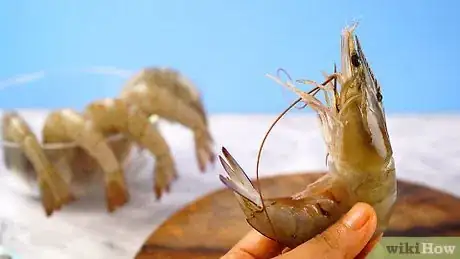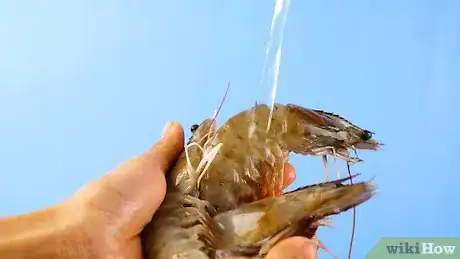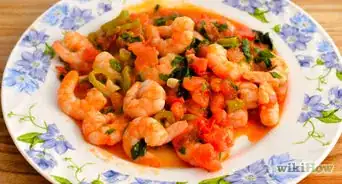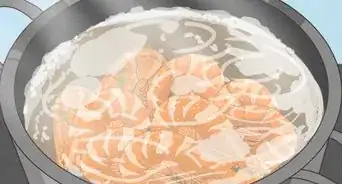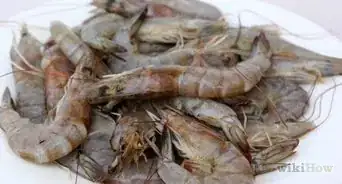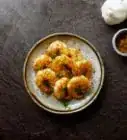This article was co-authored by Ed Kuoha. Ed Kuoha is a Chef and the Owner of Kuoha Culinary based in Aiea, Hawaii. He has more than 20 years of experience in various culinary kitchens and settings such as Morimoto Waikiki, where he received hands-on training from Iron Chef Morimoto. Chef Ed specializes in small catering events and private chef requests. He holds an Associate’s degree from The Culinary Institute of the Pacific at Kapiolani Community College.
There are 7 references cited in this article, which can be found at the bottom of the page.
wikiHow marks an article as reader-approved once it receives enough positive feedback. In this case, 100% of readers who voted found the article helpful, earning it our reader-approved status.
This article has been viewed 199,657 times.
Cleaning and preparing raw or cooked shrimp involves essentially the same steps. Whatever kind of shrimp you've got on your hands, you can learn to check them for freshness and get them ready for whatever shrimp dish you've got in mind.
Steps
-
1Check the shrimp for freshness. All shrimp should be kept refrigerated between 32 and 38 F. Raw shrimp should be consumed within 48 hours of purchase, while cooked shrimp should be consumed within 5-7 days. Frozen shrimp is usually good for up to 5 or 6 months.[1]
- Cooked shrimp should be firm, pinkish-white, and should not have a strong fishy odor. Some cooked shrimp will have head, legs, carapace, and shell all attached, while others will have some combination of these.
- Raw shrimp should be firm, translucent, and somewhat shiny, with no noticeable odor. Most of the time, raw shrimp will have the legs and shell, and often the head attached.
- Frozen shrimp, cooked or raw, should be defrosted in the refrigerator overnight, before attempting to clean or devein them. It's also possible to remove the number of shrimp you plan to use, and defrost them in cold water, in a bowl, in the sink. It should only take 20-30 minutes.[2]
-
2Rinse the shrimp. Place shrimp in a colander, washing them thoroughly with cold water. Inspect the shrimp closely for signs of spoilage while you're rinsing them, and discard any that appear slimy, discolored, or which smell overly fishy.[3]
- Only rinse and defrost shrimp in cold water, no warmer than room temperature. Shrimp cook very quickly, and running them through hot water will result in gummy, rubbery shrimp.
Advertisement -
3Remove the heads. According to chef Ed Kuoha, "there's a little connection [on the shell] where the head connects to the body." He recommends you use kitchen shears to cut the connection and remove the head. Alternatively, you can pinch the head between your index finger and thumb, just where it meets the body, and hold the body firmly with your other hand. Pinch and twist the head, until it comes free. [4] .
- Not all shrimp come head-on, and some people prefer leaving them during cooking, to help flavor the meal. They're fine to eat, if a little strange. If the thought makes you squeamish, remove them.
- Discard the heads into a separate bag from your household trash or a plastic storage bag and take out quickly, or it'll start to smell. You can also save heads for making homemade seafood stock.
-
4Remove the legs. After the head has been removed, turn the body "belly" up, facing you. Grasp all the legs firmly in your fingertips, tearing them down toward the tail. Chef Ed Kuoha explains, "pull the leg part [of the shell] and the rest follows." When you get to the tail site, break the legs off and keep the tail on. The legs should come off relatively easily, but you might not be able to get them all at once. Go back and pull any stubborn legs individually.[5]
-
5Remove the shell. At this point, there are a few different ways to proceed, all effective, depending on whether you've got raw or cooked shrimp. Chef Ed Kuoha offers a quick way to peel: "you can start from the tail end [where the legs were removed], and pull." The action will be akin to opening a jacket, where the jacket is the shrimp's shell.[6]
- Use your fingernail, or a small paring knife to get the carapace started, pull it back and off the shrimp in segments. Chef Ed Kuoha suggests, "cut [the connections] along the spine of the shrimp, [stopping] just before the end—always leave the last one because if you go all the way to the tail, the tail falls off." If you prefer, you can also start where the head was removed, pulling the shell off down the back ridge of the shrimp. Equally effective.
- Alternatively, you can use your knife to cut along the curved back ridge of the shrimp, where the vein will be, cutting through the shell to separate and remove it along the sides. Since you'll need to remove the vein of raw shrimp anyway, it's common to use this method for raw shrimp.
-
6Remove the tail, if you want. More often, shrimp is cooked with the tail on, depending on how you want to cook it. It's also fine to remove the tail, pulling it off. You can use a small knife to slit along the underside of the tail, if you have trouble getting it off.[7]
-
7Remove the vein. Along the back ridge of the shrimp there is a dark vein, which is the shrimp's intestinal tract. With a deveining knife or a paring knife, this can be removed by cutting into the shrimp, straight along this ridge, just deep enough to reach the vein to pull it out.[8]
- You don't need to cut down very far – just until you reach the vein (about halfway through the shrimp).
- Tease out the vein with the tip of your knife, then grab it with your fingers and pull it back toward the tail of the shrimp. It should come loose easily. Make sure it's all removed.
-
8Store shrimp properly. Rinse the shrimp in cold water to remove any loose shell bits, or gunk from the inside of the shrimp. It's usually best to cook raw shrimp right away, after cleaning, or you can store them loosely in the refrigerator for up to 24 hours until you want to cook them.[9]
- Shrimp should be stored in the fridge, between 32 and 38 degrees F, in cling wrap or in an airtight container.
Community Q&A
-
QuestionDoes the vain on the bottom of the shrimp have to be removed?
 Community AnswerNo, it doesn't. This is strictly up to personal taste. On large shrimp, the vein can be quite a mouthful, but on smaller shrimp you won't even notice it. Fully cooked, the vein won't hurt you.
Community AnswerNo, it doesn't. This is strictly up to personal taste. On large shrimp, the vein can be quite a mouthful, but on smaller shrimp you won't even notice it. Fully cooked, the vein won't hurt you. -
QuestionDoes the vein taste bad or hurt you?
 Jacquelyn HelmuthCommunity AnswerYou likely won't fall ill from eating fully cooked shrimp sand veins, as any bacteria in them should be destroyed during the cooking process. The vein is the digestive tract, so you might not like the idea of eating it, as you would be eating shrimp waste.
Jacquelyn HelmuthCommunity AnswerYou likely won't fall ill from eating fully cooked shrimp sand veins, as any bacteria in them should be destroyed during the cooking process. The vein is the digestive tract, so you might not like the idea of eating it, as you would be eating shrimp waste. -
QuestionHow long should I steam baby shrimp?
 Community AnswerJust until they turn pink. Shimp cook quickly so this shouldn't take more than a few minutes.
Community AnswerJust until they turn pink. Shimp cook quickly so this shouldn't take more than a few minutes.
Warnings
- Discard fishy smelling shrimp immediately. Strong odors are a sign of spoilage, in raw or cooked shrimp.⧼thumbs_response⧽
References
- ↑ http://www.clemson.edu/extension/hgic/food/food_safety/handling/hgic3482.html
- ↑ http://www.thecitycook.com/cooking/advice/faq/000041
- ↑ https://www.fsis.usda.gov/wps/portal/fsis/topics/food-safety-education/get-answers/food-safety-fact-sheets/safe-food-handling/the-big-thaw-safe-defrosting-methods-for-consumers/bigthaw2
- ↑ https://www.tasteofhome.com/article/how-to-clean-shrimp/
- ↑ https://www.aspicyperspective.com/how-to-clean-shrimp/
- ↑ https://www.aspicyperspective.com/how-to-clean-shrimp/
- ↑ https://thetakeout.com/whats-the-point-of-leaving-the-tail-on-shrimp-1829337278
- ↑ https://www.tasteofhome.com/article/how-to-clean-shrimp/
- ↑ https://www.consumerreports.org/food-safety/serve-a-safe-shrimp-cocktail-platter/
About This Article
To clean shrimp, first thaw the shrimp in a bowl of ice water. Then, rinse the shrimp thoroughly under cold water. Remove the head of each shrimp by pinching the head between your fingers and pulling it away from the body. Remove the legs on each shrimp by pulling the legs away from the body. Then, hold each shrimp with the bottom facing up and peel off the shell where the legs were removed. You can also remove the tails if you'd like by pinching them and sliding them off of the shrimp. To devein the shrimp, use a toothpick to peel out the black vein that runs along the back of the shrimp.
